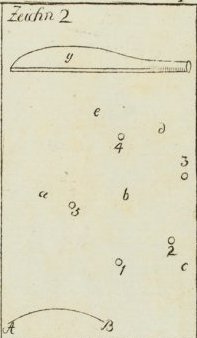Englische Base-ball: Difference between revisions
(Added illustration from original with text note) |
No edit summary |
||
| Line 1: | Line 1: | ||
[[File:Gutsmuths title page.jpg|thumb|left|220px]] | [[File:Gutsmuths title page.jpg|thumb|left|220px]] | ||
Johann Gutsmuths (1759-1839), an educator in Saxony, was one of the pioneers of the late 18th century movement to incorporate physical exercise in education; “a healthy mind in a healthy body” was something new and revolutionary. He is known in Germany as | Johann Gutsmuths (1759-1839), an educator in Saxony, was one of the pioneers of the late 18th century movement to incorporate physical exercise in education; “a healthy mind in a healthy body” was something new and revolutionary. He is known in Germany as the “grandfather of gymnastics” for his 1793 ''Gymnastik für die Jugend'', the first systematic manual of gymnastics. His follow-up book “Games for Exercise and Relaxation of Body and Mind” (''Spiele zur Uebung und Erholung des Körpers und Geistes'') was an attempt to collect into one volume the rules of every physical game Gutsmuths could find which he thought suitable for boys as part of a holistic education. This is perhaps the earliest such compendium, foreshadowing several such volumes in the 18th century, although unlike, say, ''The Boys' Own Book'' Gutsmuths' intended readership was teachers rather than boys themselves. Not all of these games were German, and for modern researchers the most notable section is that describing an English game, base-ball: the earliest known description of baseball in any language. (This noteworthy discovery was made by David Block and revealed in his 2005 ''Baseball Before We Knew It''). | ||
Revision as of 10:53, 5 March 2016
Johann Gutsmuths (1759-1839), an educator in Saxony, was one of the pioneers of the late 18th century movement to incorporate physical exercise in education; “a healthy mind in a healthy body” was something new and revolutionary. He is known in Germany as the “grandfather of gymnastics” for his 1793 Gymnastik für die Jugend, the first systematic manual of gymnastics. His follow-up book “Games for Exercise and Relaxation of Body and Mind” (Spiele zur Uebung und Erholung des Körpers und Geistes) was an attempt to collect into one volume the rules of every physical game Gutsmuths could find which he thought suitable for boys as part of a holistic education. This is perhaps the earliest such compendium, foreshadowing several such volumes in the 18th century, although unlike, say, The Boys' Own Book Gutsmuths' intended readership was teachers rather than boys themselves. Not all of these games were German, and for modern researchers the most notable section is that describing an English game, base-ball: the earliest known description of baseball in any language. (This noteworthy discovery was made by David Block and revealed in his 2005 Baseball Before We Knew It).
from Games for Exercise and Relaxation of Body and Spirit
for Boys, their Supervisors, and all Friends of the Innocent Joys of Youth (1796)
Johann Christian Friedrich Gutsmuths
3. Ball with Sanctuaries [Freystätten] (or the English Base-ball)
In describing this game I can be brief, because it parallels the play of the German Ballgame [deutsche Ballspiel] in the main; therefore I shall address my description to those players who already understand the German Ballgame.
Almost everything in Baseball, as it is commonly pursued in England, is smaller and affords less physical exertion [Kraftäußerung] in hitting, running etc. On the other hand, it requires just as much if not more concentration and even more adherence to all sorts of little rules. The German Ballgame, as enjoyable as it also is, can never completely replace it. It is played, as in the former, with two parties, of which one is the “serving” [dienende] and the other the “ruling” [herrschende]. Their roles are on the whole as in the German Ballgame; one hits, runs etc.
The distinction lies in the following. The bat [Raquett] is lighter [leichter, alt. “easier”], a shoe eight inches long, at its widest point four inches broad, an inch thick, and looks like Figure 2 y.[1] One can therefore only make short flips. The pitcher [Aufwerfer] stands five to six strides from the batter [Schläger] and tosses him the ball in an elongated bow. A curved line A—B, Figure 2, marks the batting crease [Schlagmal]; from here the ball is struck as in the German Ballgame.
Instead of the fielding crease [Fangmal], to the side as many bases [Freiplätzen, “free places”] as there are players in one party are defined by posts and marked with handkerchiefs, but the batting crease is also counted as a base. They are marked with 1, 2, 3, 4, 5 [in Figure 2] and will be ten to fifteen steps from each other in an arbitrary direction. The hitter has three swings in an at-bat. If one has touched the ball even so much that one can hear it swish, or with barely enough strength that the ball travels out of the crease, or has swung through three times, he must run from A—B through the other bases one by one until he comes back to the crease again. Since there are as many bases as there are people on one team, accordingly the more players the longer the running circuit will be. The “serving” stand arbitrarily behind, next to and between these bases, e.g. at a, b, c, d, e, because the ball will be hit there.
The bat can be lost by the “ruling” party in three ways: namely, by catching, burning or touching. I will explain these three cases; then the rules and laws of play will have been given.
1) Catching: If the batted ball is caught by any of the “serving” who wants to, under the same conditions as in the German Ballgame, then the other party has lost the bat. This is the most secure and argument-free way to win the bat, only the person who caught must call to his fellow “serving” “In, in!” or “Into the crease!” and when they are running there and almost finished, then he must throw the ball backwards over his head so as not to be caught by the losing party (for the explanation, see below under 3e), and run into the crease himself. The throw is backwards so that it cannot be thrown too far.
2) Burning: It occurs in two cases
- a) If a running hitter forgets to touch a base with his hand, then the first, best “server” who notices it runs after the ball, without specifying the reason or tipping off his teammates with secret gestures, to the untouched base, calls to his teammates “In, in!” and throws the ball at the base with the exclamation, “Burned!” The throw has to be made so that the ball only just touches and then continues flying, and the thrower must then run quickly into the crease. (for the Why, see under 3e)
- b) If there are no batters in the crease, the pitcher takes the ball, calls again to his “serving” teammates, “In!” and under the cry “Burned!” throws it at an oblique angle into the base of the crease, so that it flies further away and does not remain in the same place. But he himself must not be within the arc AB while throwing and must at once leap in after the throw.
3) Touching or throwing: No batter who is outside the crease may be touched by the ball, if it has been thrown, or his party has lost the bat. This rule is very effective and manifests itself in the following cases.
- a) If the batter has struck the ball, he runs to 1, 2, 3 etc. until the ball is thrown into the crease; he may not go further, but must stay at the base where he is, until a new hit occurs, or the ball in some other manner comes out of the crease; during this running, any “server” may throw at him, and thus his party's bat is gone. It was already said above that the batter in the crease has the right to three swings; if he fails to hit the ball on all three, he must still run, and then the pitcher has the ball right by his hand, and so usually can throw at him. He hits the runner before he touches the first base, thus the bat is lost. The same case always applies when the ball is so little touched that it does not fly far.
- b) If several batters have already hit and run, so that several bases are occupied. Let us assume that this is the case at 3 and 4. Now it occurs that on a new hit the person on 3 runs further, but that 4 out of carelessness or because a “server” with the ball is too close, stays in place, and consequently there are two persons on base 4. This is contrary to the order of the game, that at all times only one person may stay at a base. In this case if the person on 4 does not run quickly to 5, or the trailing runner return again to 3, then the first, best “server” who has the ball or quickly calls for it can run there and either throw at the runner or burn one of the bases in the above manner, and then the bat is lost.
- c) When a hit occurs, each runner may always run from one base to another, until the “servers” throw the ball into the crease. Then he has to remain at the base where he is standing. However, he may be more than about halfway to the next base, and can thereupon run the rest of the way. But if he errs and continues running after the arrival of the ball in the crease, if he does not quickly run back then any “server” can hurry over and touch him with the ball, or burn the base. In both cases the bat is lost. The same applies if he is hit with the ball while running back.
- d) When a hitter, without the permission of the pitcher, goes outside the batting crease A—B, then he can touch him in the same manner and the bat is lost.
- e) If any of Party A, which hitherto has been at bat, loses the bat in any of the manners 1, 2, 3 aforesaid, from that moment the formerly “serving” Party B becomes the Rulers. Then all persons from B, who still stand outside, in the moment of victory rush extremely quickly into the crease; now if anyone from A obtains the ball and can hit anyone from B who is still outside the crease with it, so B has lost the bat again and A is again “ruling.” Contrariwise, now B from this moment has the right to touch any of A. If they do so, then they are again “ruling.” Therefore this will produce a very funny albeit brief ongoing battle, and the party which remains “ruling” at the end is whichever one schooled [beibrachte] one of the others with the last throw. Herein lies the reason why when catching the ball is thrown away backwards and when burning and touching must be thrown so that it flies farther away from the throwing target, so that none from the opposing party can immediately seize it and throw it back.
From the forgoing is given at the same time what each party has to do. This game has all the advantages of the German Ballgame, only it requires on the one hand less physical exertion and on the other hand more attention because it is bound by more rules.
(Tr. W. C. Hicklin 2016)
- ↑ The text reads acht Zoll lang; however, the illustration shows a paddle clearly more than twice as long as it is wide; conceivably acht is an error for achtzehn “eighteen”.

